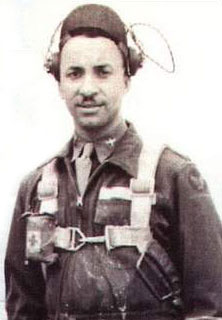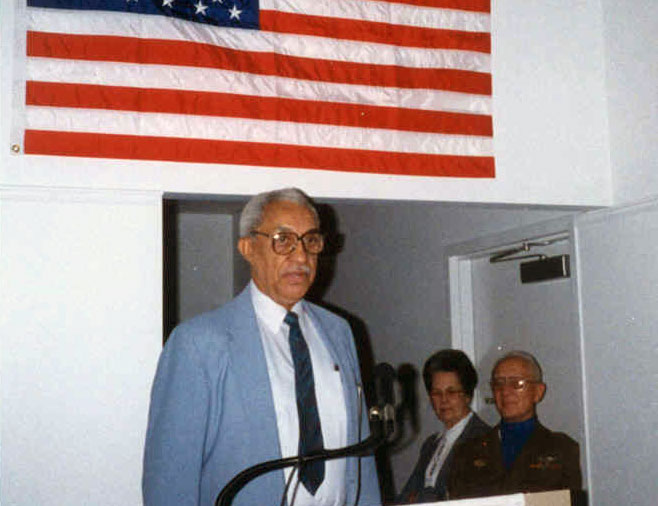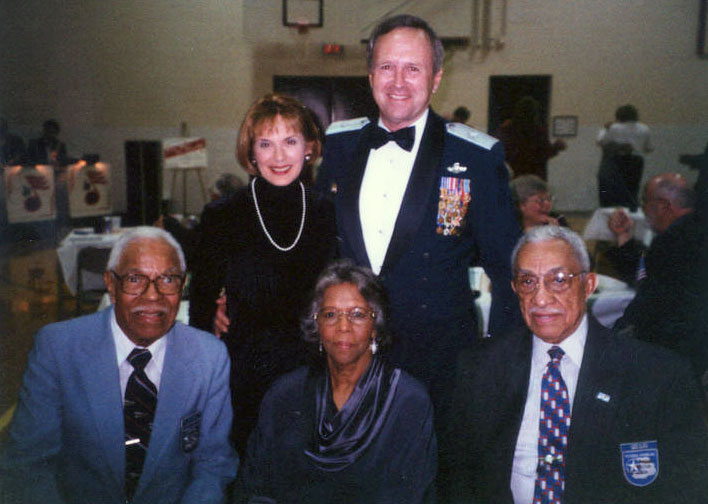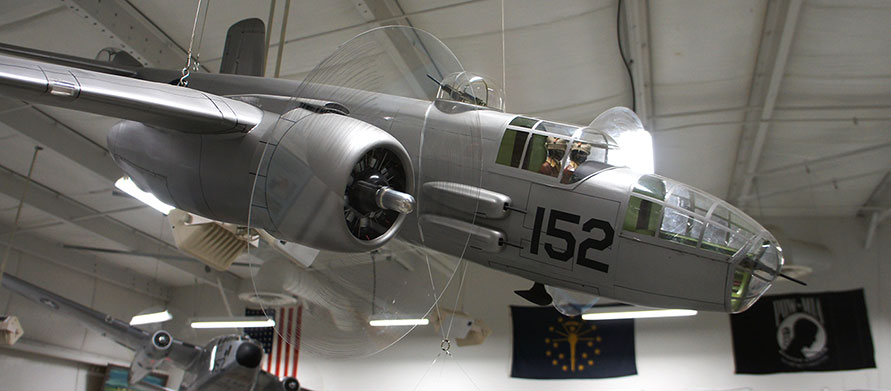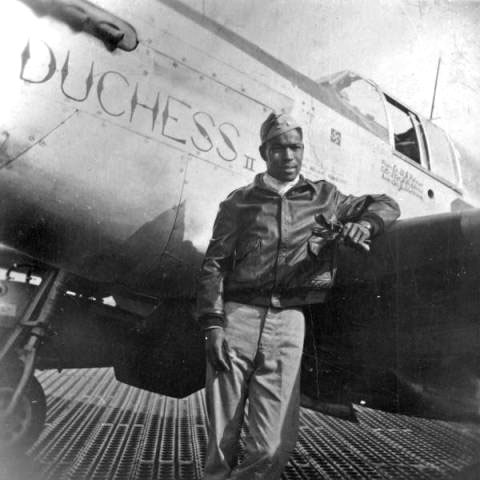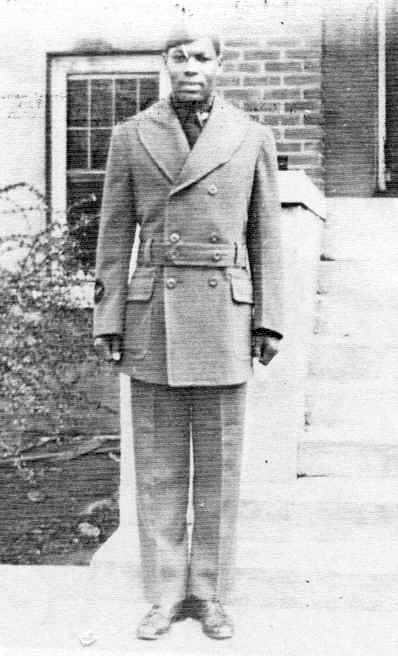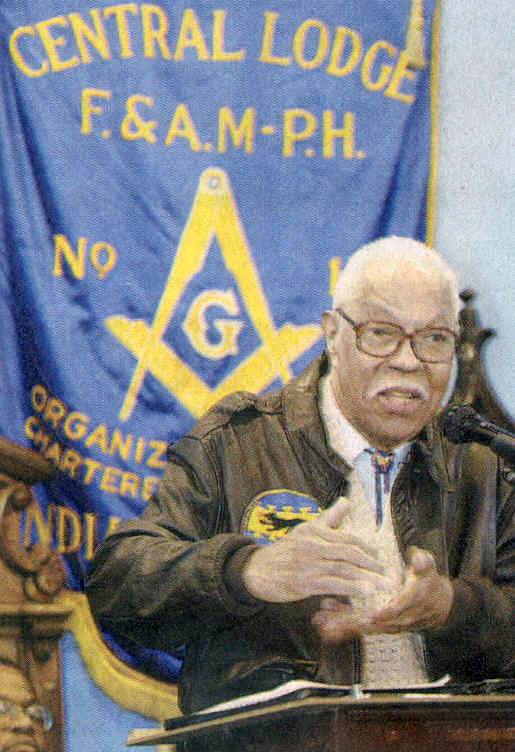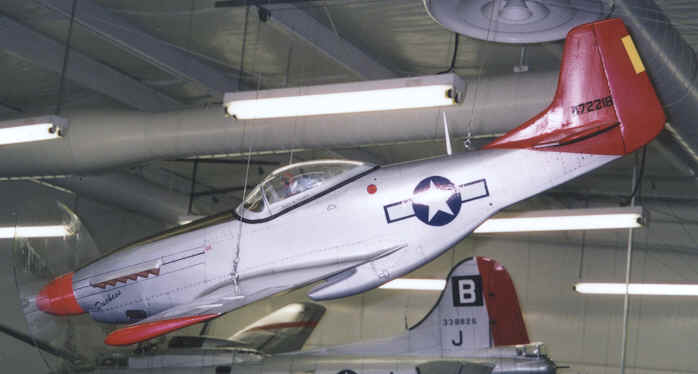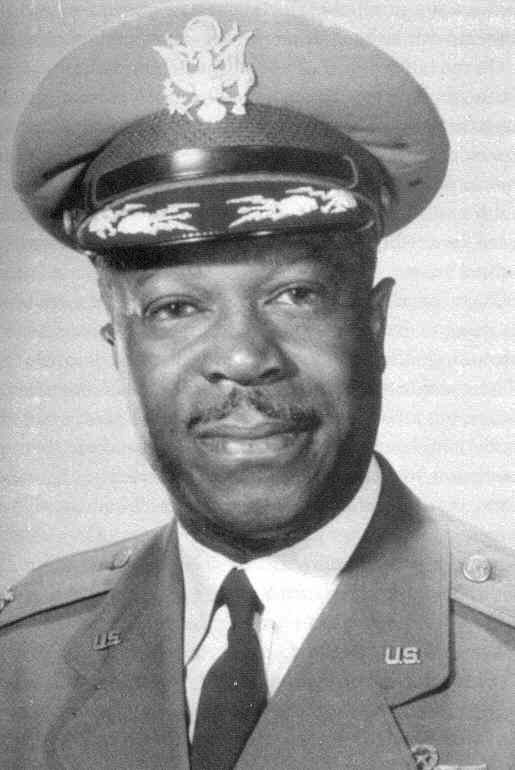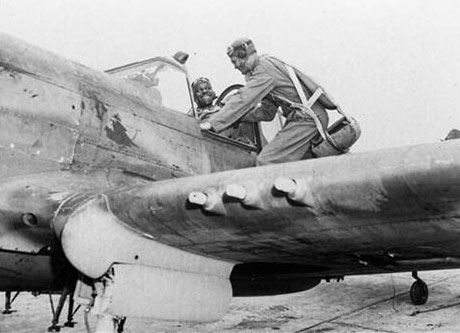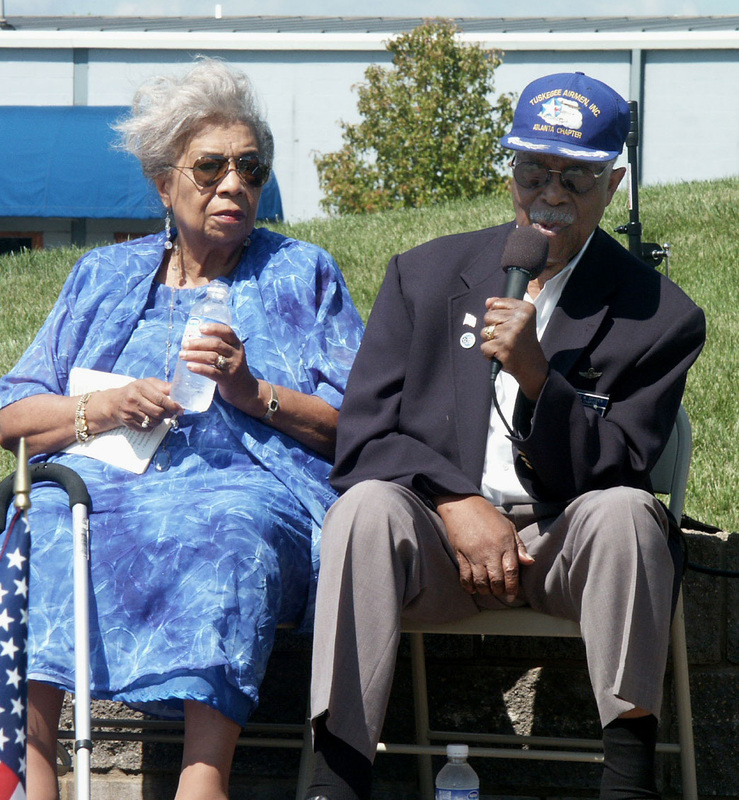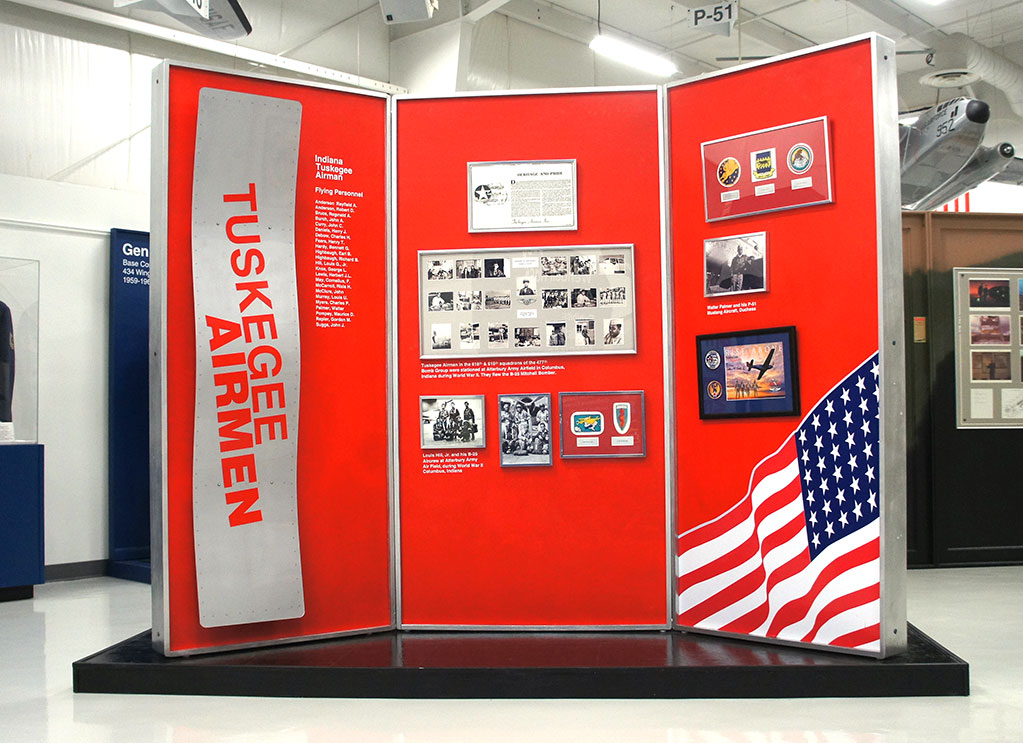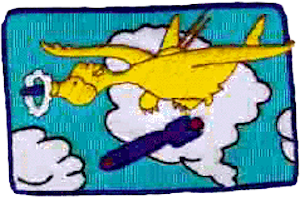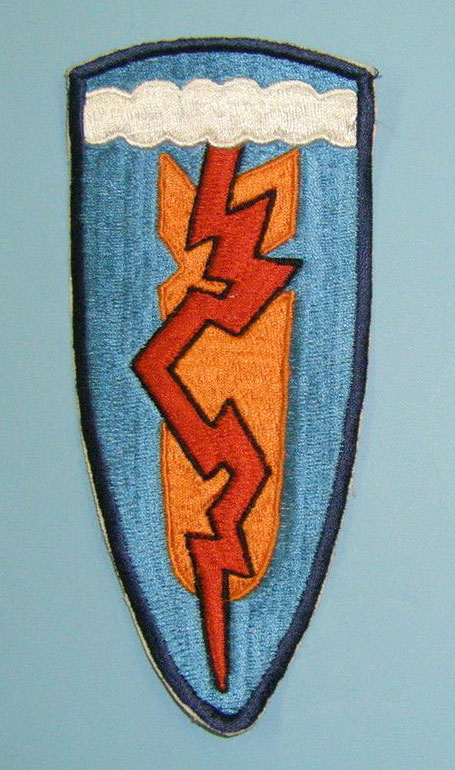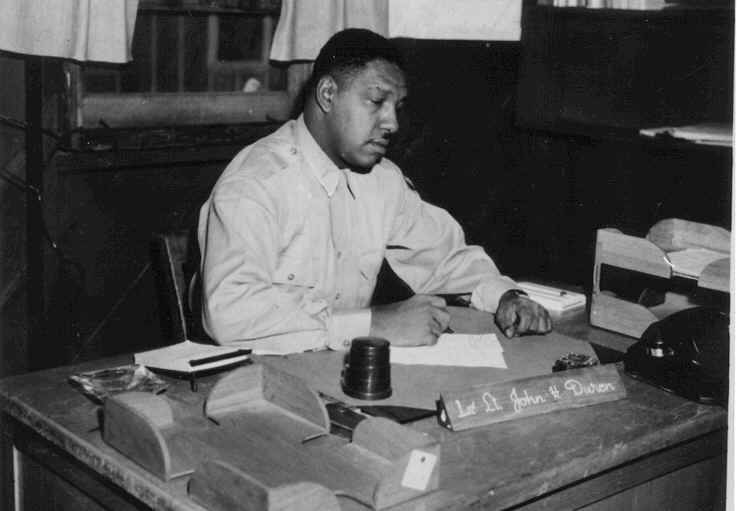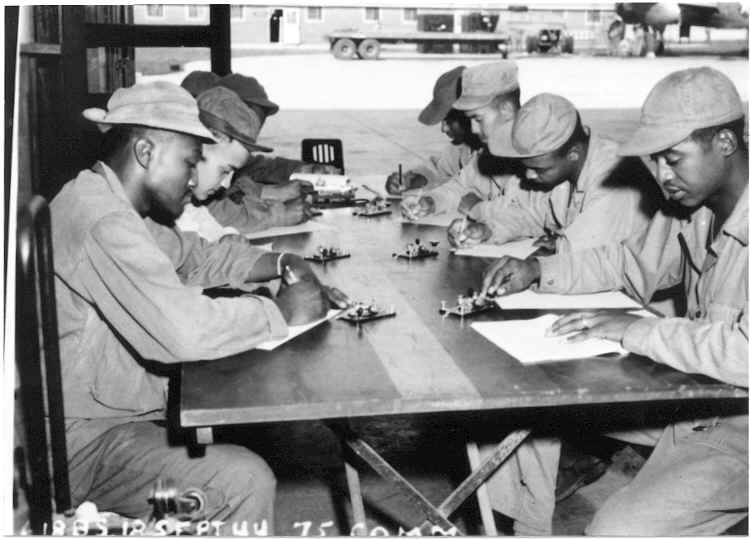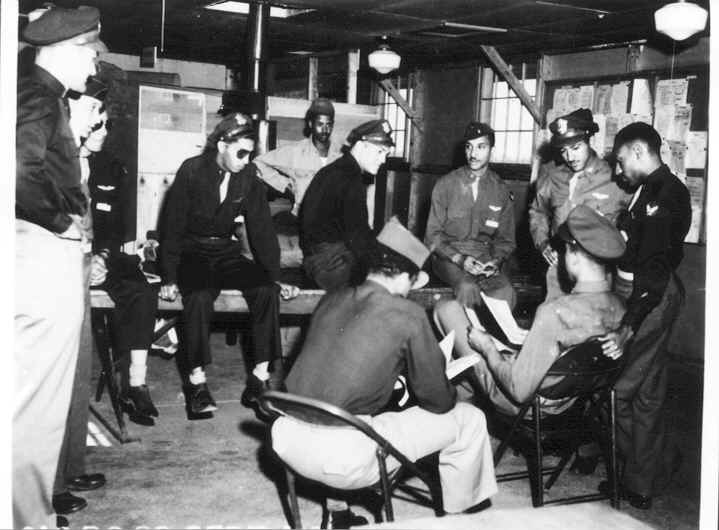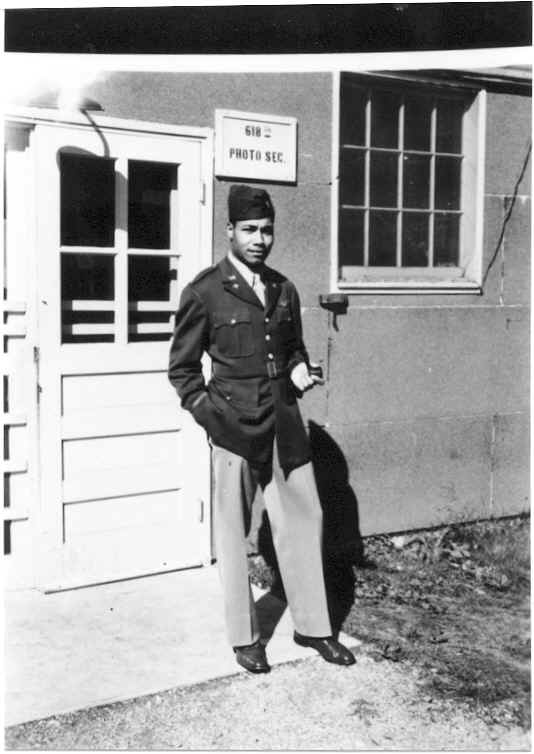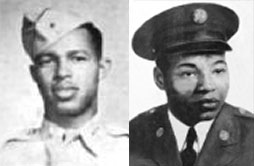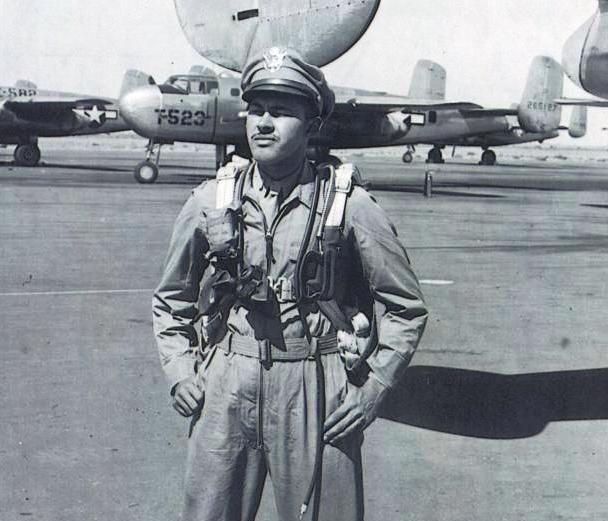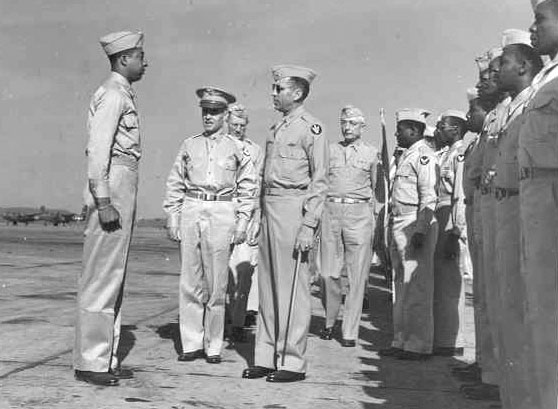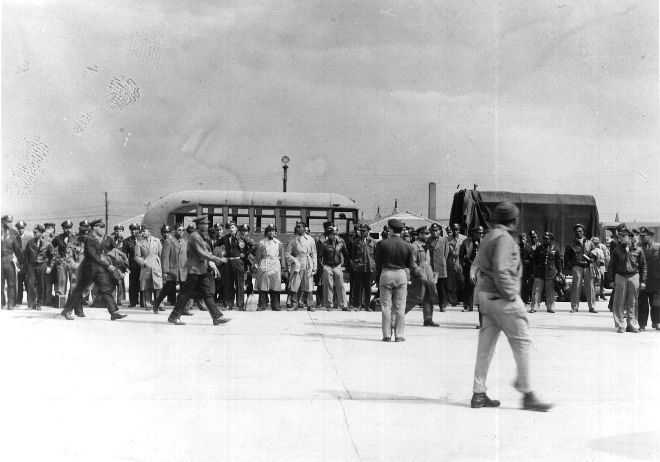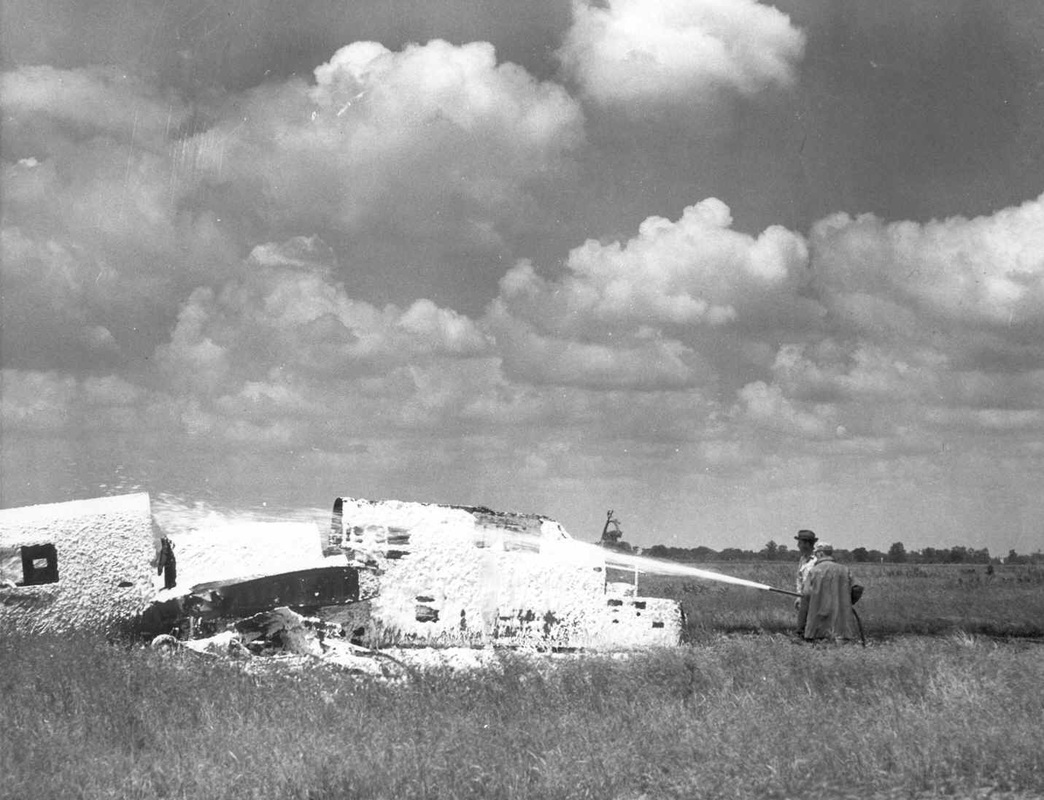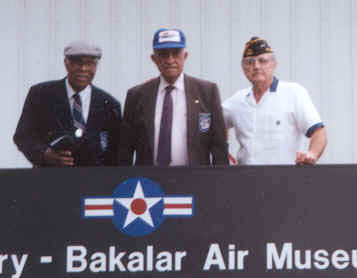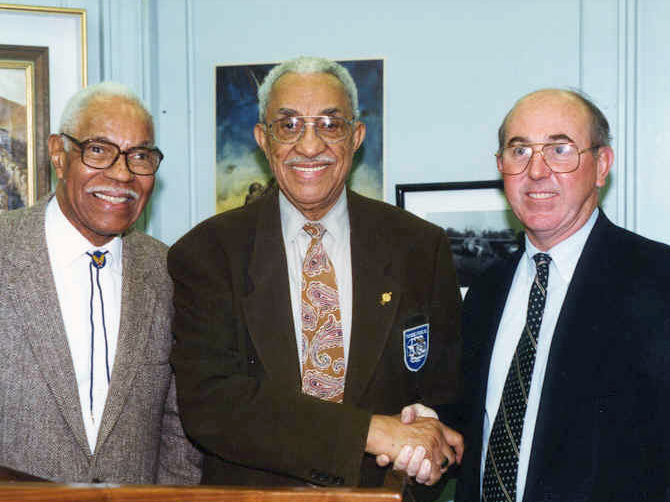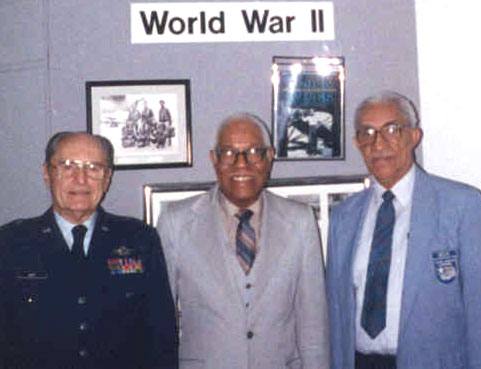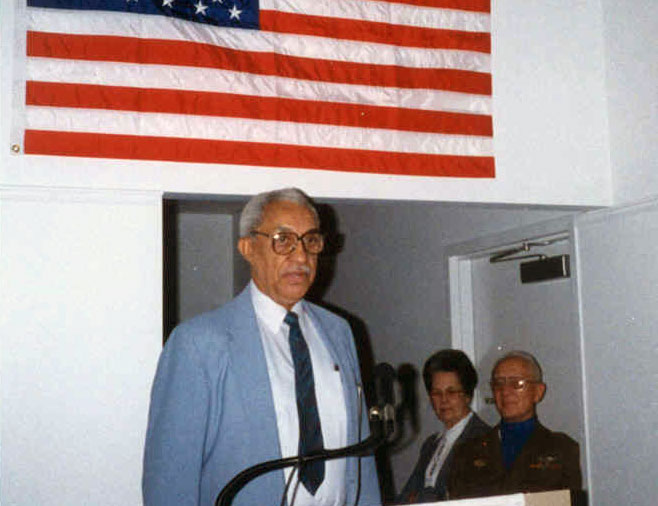THE TUSKEGEE AIRMEN : louis g. hill
|
In memory of our friend Louis G. Hill Jr. Tuskegee Airman June 28, 1916-April 25, 2007
Louis G. Hill Jr., Class 44-B, served at the former Atterbury Army Air Field as a B-25 Bomber Pilot during WWII. The Tuskegee Airmen gallery displays their history and Louis' B-25 Bomber in 1/8 scale is suspended above that display. Louis in his flight suit during WWII |
Louis at the museum for the dedication of his B-25 Bomber display.
Major General Mark Pillar with Walter and Louis at the Honoring Veterans Banquet in Columbus, Indiana.
Louis and his fellow Tuskegee Airman, Walter Palmer, Class 43-F, were long-time friends and supporters of the Atterbury-Bakalar Air Museum. The Indiana Aviation Hall of Fame display at the museum honors the Tuskegee Airman
We are honored to have known you, Louis.
Louis and his fellow Tuskegee Airman, Walter Palmer, Class 43-F, were long-time friends and supporters of the Atterbury-Bakalar Air Museum. The Indiana Aviation Hall of Fame display at the museum honors the Tuskegee Airman
We are honored to have known you, Louis.
Louis Hill's B-25 in 1/8 scale, on display at the Atterbury-Bakalar Air Museum
the tuskegee airmen : walter palmer
|
Walter flew P-39's, P-40's, P-47's and P-51's with the 100th Fighter Squadron, 332nd Fighter Group. Walter did not fly out of Atterbury Army Air Base but was a good friend of the Atterbury-Bakalar Air Museum and an important part of the Tuskegee Airmen history. Walter flew 158 combat missions with over 400 combat hours flying time. Walter served with the Tuskegee Airman from September 1942 to July 1945
Walter J.A. Palmer as pictured in an Indianapolis Star feature story about the Tuskegee Airman. |
|
Walter with Columbus, Indiana Mayor Fred Armstrong and Major General Retired John Hoff at a function at the Columbus Airport hosted by the Atterbury-Bakalar Air Museum.
Walter and fellow Tuskegee Airman Louis Hill were great friends of the museum volunteers and participated in many of the museum events. |
Lt. Colonel (Ret.) Charles W. "A-Train" Dryden
|
Lt. Colonel Dryden has been inducted into the Georgia Aviation Hall of Fame and was on the Board of Directors of the Atlanta Chapter-Tuskegee Airman, Inc. He resided with his wife Marymal in Atlanta, Georgia. Lt Colonel Dryden is the cousin of longtime Atterbury-Bakalar Air Museum friend and fellow Tuskegee Airman, Walter Palmer. Walter holds the record for the most combat missions flown by a Tuskegee Airman during WWII. A whopping 158 combat missions. Charles passed away June 24, 2008 at age 87.
|
618th and 619th Bomb Squadrons
Tuskegee Airman of the 618th and 619th Bomb Squadrons (M) of the 477th Bomb Group (M) in training at Atterbury Army Air Field in Columbus Indiana during World War II. They flew the B-25 Mitchell Bomber like the ones in the photographs. Louis Hill and his crew pictured on the right. (Click on photos to enlarge)
618 & 619 Bomb Squadron Patches
B-25 SPECIFICATIONS
Span: 67 ft. 7 in.
Length: 52 ft. 11 in.
Height: 15 ft. 9 in.
Weight: 28,460 lbs. loaded
Armament: Five .50-cal. machine guns; 5,000 lbs. of bombs
Engine: Two Wright R-2600's of 1,700 hp. ea.
Cost: $96,000
PERFORMANCE
Maximum speed: 275 mph.
Cruising speed: 230 mph.
Range: 1,200 miles
Service Ceiling: 25,000 ft
Length: 52 ft. 11 in.
Height: 15 ft. 9 in.
Weight: 28,460 lbs. loaded
Armament: Five .50-cal. machine guns; 5,000 lbs. of bombs
Engine: Two Wright R-2600's of 1,700 hp. ea.
Cost: $96,000
PERFORMANCE
Maximum speed: 275 mph.
Cruising speed: 230 mph.
Range: 1,200 miles
Service Ceiling: 25,000 ft
Daily life at Atterbury Army Air Field for the Tuskegee Airmen in 1944
There is a monument dedicated to the Tuskegee Airmen located on Bakalar Green between the Control Tower and Rotating beacon a short walk from the Atterbury-Bakalar Air Museum front door.
Tuskegee Airman who served at Atterbury Army Air Field
|
Arthur Saunders on the left, and Thomas Austin, Sr. on the right.
Pictured here are some of the Tuskegee Airman who served at Atterbury Army Air Field. Museum research indicates these Tuskegee Airmen at one time served at the former air base in Columbus, IN. Maurice Pompey featured bottom left 1st Lt. Arthur Saunders earned his pilot's license in 1941. He received his commission at Yale University in Armament, Bombsight, and Engineering and trained at Tuskegee, AL. He was one of the first officers to serve in the 477th. 1st Lt. Maurice Pompey was born in South Bend, IN. He was a student at Howard University when WWII began. He was assigned to the 618th Squadron of the 477th based at Atterbury Army Air Field in Columbus, Indiana for combat training. Staff Sergeant Thomas Austin, Sr. was an Aircraft Mechanic and Trained at Tuskegee, AL. He had assignments at a number of Army air fields including Atterbury Army Air Field where B-25s needed his mechanic skills. He had experience on nine aircraft types. |
|
This photograph is of Colonel Robert R. Selway reviewing the 618th Bomber Squadron at the Atterbury Army Air Field on June 24, 1944. The Tuskegee Airman that Col. Selway is facing is Hubert L. Jones, Class P43H. At Freeman Field, Seymour, Indiana, Colonel Selway segregated the Tuskegee Airman and white Officers Clubs. The Tuskegee Airman were not allowed to enter the white Officers Club under Col. Selway's orders. Suggested reading: The Freeman Field Mutiny by Lt. Col. James C. Warren USAF (Ret.) and The Tuskegee Experiment and Tuskegee Airmen 1939-1949 by LeRoy Gillead.
|
|
Tuskegee Airman of the 477th Bombardment Group being loaded on buses at Freeman Field Seymour, Indiana for transport to Godman Field, Kentucky in April 1945. This was in retaliation for their efforts to enter the segregated Officers Club at Freeman Field. 101 officers refused to sign a copy of the regulation keeping them out of the club. All 101 were arrested. The complete history of this historic event is in the book The Freeman Field Mutiny written by Lt. Colonel (Ret.) James C. Warren.
|
|
This official photograph is from the museum archives and appears to show a B-25 being sprayed with foam by the base fire department. This is one of many base fire department photographs and may be the photo of the Tuskegee Airmen B-25 which crashed during training, according to a 1944 newspaper article "B-25 slides 1,500 feet in field attempting landing." This photo may be of that aircraft but the museum staff is unable to document this.
|
|
Photographs of Tuskegee Airmen, Louis Hill, Class 44-B and Walter Palmer, Class 43F, great friends of the Atterbury-Bakalar Air Museum. Joined by Major General (Ret.) John Hoff, former Bakalar Air Force Base Commander and WWII B-17 Command Pilot in the photo in front of the Museum sign and Louis and Walter getting a warm welcome from Columbus Mayor Fred Armstrong, a decorated Vietnam Veteran. Louis and Walter are part of our Museum Family and attend many of the Museum events.
|
presentation by Tuskegee Airman Louis Hill
Honorable Master of Ceremonies, Mayor, and Distinguished Platform Guests:
The climate for race relations was extremely negative during WWII. Not only did we as Negro soldiers feel the hate of our global enemies, but we were forced, both by Army regulations and local policies, to endure severe racial segregation all over America as well. It was in this atmosphere that the Tuskegee's Pilot Program, better known as the Tuskegee experiment, began. We, as young men were determined to prove ourselves capable of the challenge and we succeeded. We first of all wanted to fly.
While in the States, we often heard of the successes of the 332nd Fighter Group, of which my friend Walter Palmer was a member. We knew through the press of Brazil, Indiana's Charlie Hall's shooting down of the FW190. The first Negro Airman to score a victory. We heard of the losses too - Harry Daniels and Burton Highbaugh, young men friends of mine from Indianapolis I'd known all my life. Burton's brother, Richard was in our group, the 477th Bomb Group (M).
It was a violent war, fueled by passion and fear. It was a tragic time when hate and prejudice forced nations to bicker and fight. It was a time when our enemies (the Axis) Japan, Italy, and Germany committed many atrocities against their own citizenry, as well as against citizens of other countries in what later became known as the Holocaust ,served by the horrors of the concentration camp. It was a time scarred by these hates. President Roosevelt spoke so eloquently of Pearl Harbor, as Japan's Day of Infamy. This stirred us. It was a season in the World's time when young men and young women inspired by words like patriotism and loyalty came together all over the nation and volunteered their services. We served too. President Roosevelt told us we had "nothing to fear but fear itself." We believed that. Such was the climate. I volunteered and was sent to Tuskegee to learn to fly. After completing flight training and transition training in B-25s, I remember our coming to this place. We had been to Selfridge Field outside of Detroit, Michigan and Godman Field near Louisville, Kentucky, and here at Atterbury Army Air Field, where we learned skip bombing and perfected instrument flying. I remember Bill "Shack" Heyward, my Navigator, and his cool, quiet personality, a steadying influence upon us all. We called him "Shack" because of his accuracy with the Norden Bomb sight. He never missed a target.
I remember the basketball games at Columbus High School, where Haldane King, from New York, played on our team, his brother "Dally" King, an alumnus of Long Island University, had been voted as an All-American that year. Halbert L. "Hooks" Jones was a forward, later one of the Chapters was named for him. He and I were Flight Leaders in the 618th Bomb Squadron (M). There were others too I remember, Ahmed Rayner, his parents owned one of the largest Funeral Homes in Chicago. Greg Harrison, a good friend and many more of my colleagues, I remember them too.
I remember playing against the teams from Cummins: one man, I don't remember his name, but he had played professional basketball with the Oshkosh, Wisconsin team. I see it so clearly now. The gym was packed with people. The cheers! I remember the townspeople and the welcome of the merchants. We often bought snacks, meats, crackers, sardines, and chips to fuel our bodies during our poker games. There was a great difference here than at Seymour. Although at Seymour, we had living quarters for our families, we disliked leaving Columbus. The people of Columbus were so much kinder and friendlier.
Rumors played a great part in our lives. Wars are uncertain. Gossip and rumors played a part, we call them latrine rumors. We were concerned about where we would go next. You, the fine people of Columbus, did so much to form a place for us. I remember the last time we were in Columbus, the taxi driver told us he hated to see us go. It was a mutual feeling.
Through the activities of many men ruled our destinies some prepared seeds of distrust in our futures and, despite this neglect within the War Department by not providing us with crews, we were prepared as pilots, navigator-bombardiers, engineers, radio operators, and armorers. We did not go to war. We were prepared though.
You, at this place, did so much to form a place for us. I thank you for that. I'm grateful for that.
Such was WWII that Winter of 1944. I shall never forget you.
GOD BLESS YOU ALL.
Louis Hill, Tuskegee Airman, November 11, 1992
The climate for race relations was extremely negative during WWII. Not only did we as Negro soldiers feel the hate of our global enemies, but we were forced, both by Army regulations and local policies, to endure severe racial segregation all over America as well. It was in this atmosphere that the Tuskegee's Pilot Program, better known as the Tuskegee experiment, began. We, as young men were determined to prove ourselves capable of the challenge and we succeeded. We first of all wanted to fly.
While in the States, we often heard of the successes of the 332nd Fighter Group, of which my friend Walter Palmer was a member. We knew through the press of Brazil, Indiana's Charlie Hall's shooting down of the FW190. The first Negro Airman to score a victory. We heard of the losses too - Harry Daniels and Burton Highbaugh, young men friends of mine from Indianapolis I'd known all my life. Burton's brother, Richard was in our group, the 477th Bomb Group (M).
It was a violent war, fueled by passion and fear. It was a tragic time when hate and prejudice forced nations to bicker and fight. It was a time when our enemies (the Axis) Japan, Italy, and Germany committed many atrocities against their own citizenry, as well as against citizens of other countries in what later became known as the Holocaust ,served by the horrors of the concentration camp. It was a time scarred by these hates. President Roosevelt spoke so eloquently of Pearl Harbor, as Japan's Day of Infamy. This stirred us. It was a season in the World's time when young men and young women inspired by words like patriotism and loyalty came together all over the nation and volunteered their services. We served too. President Roosevelt told us we had "nothing to fear but fear itself." We believed that. Such was the climate. I volunteered and was sent to Tuskegee to learn to fly. After completing flight training and transition training in B-25s, I remember our coming to this place. We had been to Selfridge Field outside of Detroit, Michigan and Godman Field near Louisville, Kentucky, and here at Atterbury Army Air Field, where we learned skip bombing and perfected instrument flying. I remember Bill "Shack" Heyward, my Navigator, and his cool, quiet personality, a steadying influence upon us all. We called him "Shack" because of his accuracy with the Norden Bomb sight. He never missed a target.
I remember the basketball games at Columbus High School, where Haldane King, from New York, played on our team, his brother "Dally" King, an alumnus of Long Island University, had been voted as an All-American that year. Halbert L. "Hooks" Jones was a forward, later one of the Chapters was named for him. He and I were Flight Leaders in the 618th Bomb Squadron (M). There were others too I remember, Ahmed Rayner, his parents owned one of the largest Funeral Homes in Chicago. Greg Harrison, a good friend and many more of my colleagues, I remember them too.
I remember playing against the teams from Cummins: one man, I don't remember his name, but he had played professional basketball with the Oshkosh, Wisconsin team. I see it so clearly now. The gym was packed with people. The cheers! I remember the townspeople and the welcome of the merchants. We often bought snacks, meats, crackers, sardines, and chips to fuel our bodies during our poker games. There was a great difference here than at Seymour. Although at Seymour, we had living quarters for our families, we disliked leaving Columbus. The people of Columbus were so much kinder and friendlier.
Rumors played a great part in our lives. Wars are uncertain. Gossip and rumors played a part, we call them latrine rumors. We were concerned about where we would go next. You, the fine people of Columbus, did so much to form a place for us. I remember the last time we were in Columbus, the taxi driver told us he hated to see us go. It was a mutual feeling.
Through the activities of many men ruled our destinies some prepared seeds of distrust in our futures and, despite this neglect within the War Department by not providing us with crews, we were prepared as pilots, navigator-bombardiers, engineers, radio operators, and armorers. We did not go to war. We were prepared though.
You, at this place, did so much to form a place for us. I thank you for that. I'm grateful for that.
Such was WWII that Winter of 1944. I shall never forget you.
GOD BLESS YOU ALL.
Louis Hill, Tuskegee Airman, November 11, 1992
View the Tuskegee Airmen exhibit HERE >
